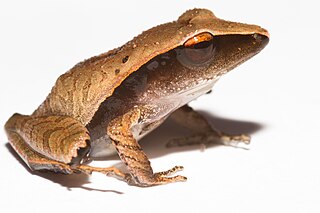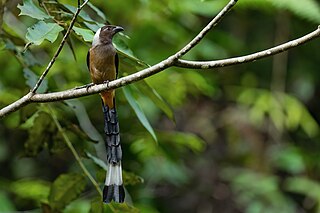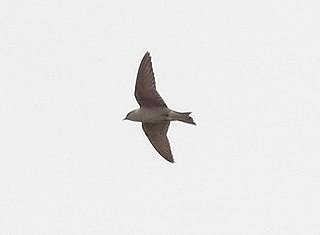Smith's woolly bat is a species of vesper bat in the family Vespertilionidae. It is found in Cameroon, Democratic Republic of the Congo, Kenya, Nigeria, and Uganda. Its natural habitats are subtropical or tropical dry forests, subtropical or tropical moist lowland forests, subtropical or tropical swamps, and subtropical or tropical moist montane forests.
Miller's striped mouse or the Liberian forest hybomys is a species of rodent in the family Muridae. It is found in Ivory Coast, Guinea, Liberia, and Sierra Leone. Its natural habitats are subtropical or tropical dry forest, subtropical or tropical moist lowland forest, and subtropical or tropical moist montane forest.

The long-billed partridge is a species of bird in the family Phasianidae.
Gymnopis syntrema is a species of caecilian in the family Dermophiidae. It is found in Belize, Guatemala, and possibly Honduras. Its natural habitats are subtropical or tropical moist lowland forests, subtropical or tropical moist montane forests, plantations, rural gardens, and heavily degraded former forest. It is threatened by habitat loss.
The common forest tree frog is a species of frog in the family Arthroleptidae found in Angola, Cameroon, the Republic of the Congo, the Democratic Republic of the Congo, Equatorial Guinea, Gabon, Nigeria, and possibly the Central African Republic. Its natural habitats are subtropical or tropical moist lowland forest, subtropical or tropical moist montane forest, subtropical or tropical high-altitude grassland, rivers, intermittent freshwater marshes, and heavily degraded former forests.

Craugastor gollmeri is a species of frog in the family Craugastoridae. It is found in Costa Rica and Panama. Its natural habitats are subtropical or tropical moist lowland forests, subtropical or tropical moist montane forests, rural gardens, and heavily degraded former forest. It is threatened by habitat loss.

The Antilles coqui, commonly known as the Montserrat whistling frog, Barbados whistling frog, or the Lesser Antillean whistling frog, is a species of frog in the family Eleutherodactylidae found in Bermuda, the Caribbean and northern South America. Its natural habitats are subtropical or tropical moist lowland forest, subtropical or tropical moist montane forest, subtropical or tropical moist shrubland, subtropical or tropical dry lowland grassland, arable land, pastureland, plantations, rural gardens, urban areas, and heavily degraded former forests.

The Angola river frog, or common river frog, is a species of frog in the family Pyxicephalidae. Formerly, it was placed in the family Ranidae.

Anchieta's ridged frog or plain grass frog is a species of frog in the family Ptychadenidae. It is found in Angola, Botswana, Republic of the Congo, Democratic Republic of the Congo, Djibouti, Eritrea, Eswatini, Ethiopia, Kenya, Malawi, Mozambique, Namibia, Somalia, South Africa, Sudan, Tanzania, Uganda, Zambia, Zimbabwe, possibly Burundi, and possibly Rwanda. Its natural habitats are subtropical or tropical moist lowland forest, subtropical or tropical moist montane forest, dry savanna, moist savanna, subtropical or tropical dry shrubland, subtropical or tropical moist shrubland, subtropical or tropical dry lowland grassland, rivers, intermittent rivers, freshwater lakes, freshwater marshes, intermittent freshwater marshes, hot deserts, arable land, rural gardens, urban areas, and ponds.

The Mascarene grass frog, or Mascarene ridged frog, is a species of frog in the family Ptychadenidae. It is found in sub-Saharan Africa, Madagascar, and Mauritius.
Ptychadena neumanni is a species of frog in the family Ptychadenidae. It is endemic to Ethiopia.
Ptychadena porosissima is a species of frog in the family Ptychadenidae. It is found in Angola, Democratic Republic of the Congo, Ethiopia, Kenya, Malawi, Rwanda, South Africa, Eswatini, Tanzania, Uganda, Zambia, Zimbabwe, possibly Burundi, possibly Lesotho, and possibly Mozambique. Its natural habitats are temperate forest, subtropical or tropical moist montane forest, moist savanna, subtropical or tropical moist shrubland, temperate grassland, subtropical or tropical seasonally wet or flooded lowland grassland, subtropical or tropical high-altitude grassland, swamps, intermittent freshwater marshes, pastureland, rural gardens, and heavily degraded former forest.

The marbled snout-burrower is a species of frog in the family Hemisotidae. It is found in sub-Saharan Africa. Its natural habitats are subtropical or tropical dry forest, subtropical or tropical moist lowland forest, dry savanna, moist savanna, subtropical or tropical moist shrubland, subtropical or tropical high-altitude grassland, swamps, freshwater lakes, intermittent freshwater lakes, freshwater marshes, intermittent freshwater marshes, arable land, plantations, seasonally flooded agricultural land, and canals and ditches. It is also called the mottled shovelnose frog and marbled shovelnose frog.

The Sumatran treepie or Sunda treepie is a species of bird in the family Corvidae. It is endemic to the island of Sumatra in Indonesia. Its natural habitats are subtropical or tropical moist lowland forest and subtropical or tropical moist montane forest. The Bornean treepie is sometimes considered to be a subspecies of this bird.

The yellow-vented flowerpecker is a species of bird in the family Dicaeidae. It is found in Bangladesh, Bhutan, Brunei, Cambodia, China, India, Indonesia, Laos, Malaysia, Myanmar, Nepal, Singapore, Thailand, and Vietnam. Its natural habitats are subtropical or tropical moist lowland forest and subtropical or tropical moist montane forest. Along with D. melanoxanthum, D. agile, and D. everetti, it is often referred to as an “odd” Dicaeum species because of unique characteristics separating it from other species within the family. While most species have vestigial outermost primary feathers, those of the yellow-vented flowerpecker are elongated.

The Tinian monarch is a species of bird in the family Monarchidae. It is endemic to the Northern Mariana Islands.

The southern martin is a species of bird in the family Hirundinidae.

The Peruvian martin is a species of bird in the family Hirundinidae. It is found in Peru and far northern Chile.

The Bioko forest shrew or Isabella's shrew is a species of mammal in the family Soricidae found in Cameroon and Equatorial Guinea. Its natural habitats are subtropical or tropical moist montane forest and subtropical or tropical high-elevation grassland.

The large-eared free-tailed bat is a species of bat in the family Molossidae native to Africa.















